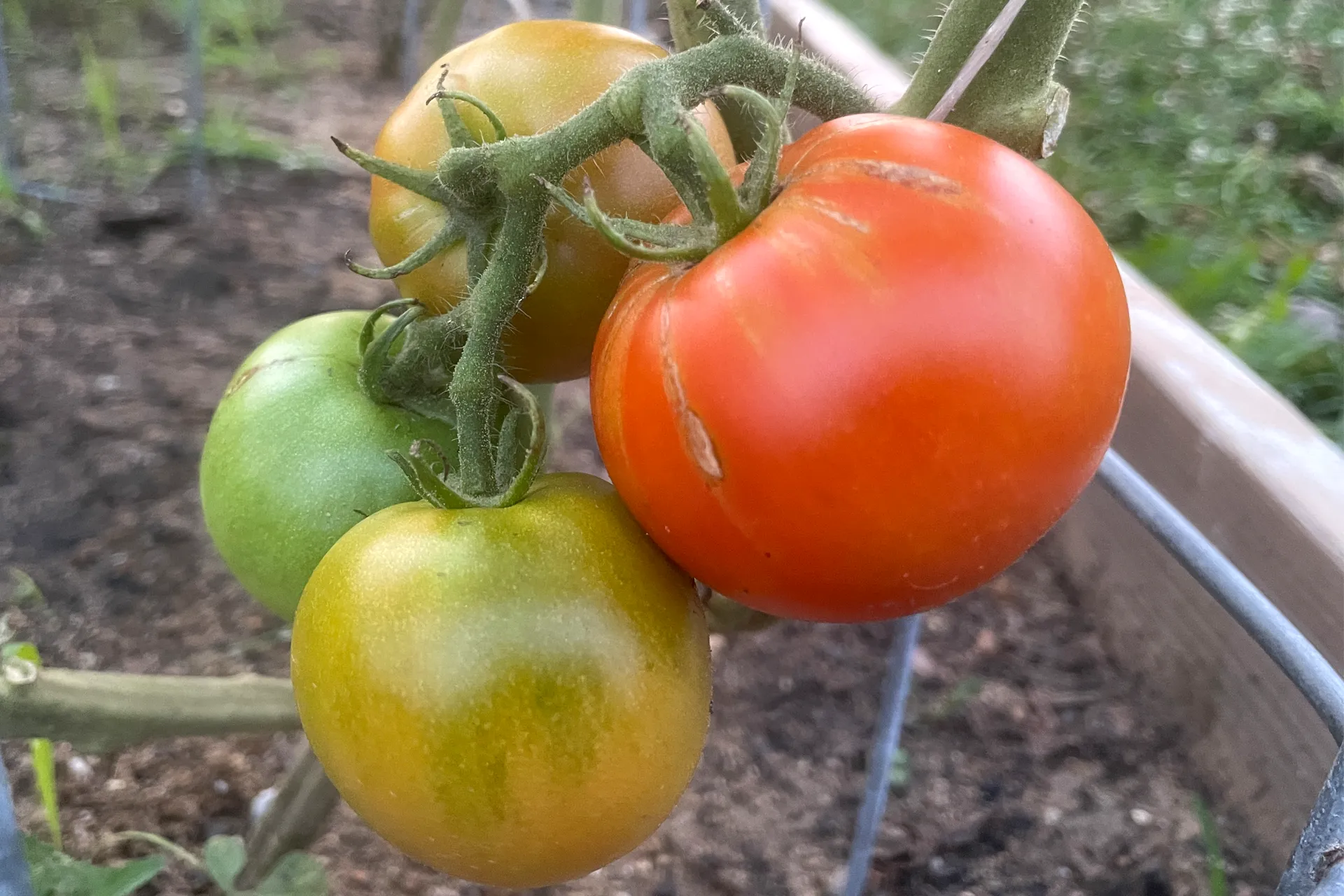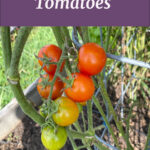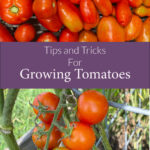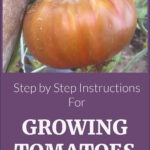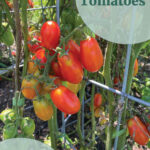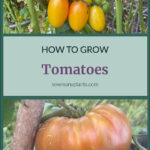This post may contain affiliate links. When you purchase through links on my site, I may earn a commission at no cost to you. See my Privacy Policy for details.
Growing tomatoes is one of my favorite things to do in the summer. Tomatoes are one of the most popular and versatile vegetables to grow in the garden. They are nutritious, and delicious, making them a great addition to any meal. They are easy to grow and can be enjoyed fresh, canned, or cooked in a variety of dishes. In this article, we’ll cover everything you need to know to successfully plant and care for tomatoes in your garden.
Types of Tomatoes
Tomatoes come in a wide variety of shapes, sizes, colors, and flavors. Here are some of the most common types of tomatoes you might consider when growing tomatoes in your garden:
- Cherry Tomatoes: These are small, bite-sized tomatoes that are perfect for snacking or adding to salads. They come in a range of colors, including red, yellow, and even black.
- Beefsteak Tomatoes: These are large, juicy tomatoes that are perfect for slicing and adding to sandwiches or burgers. They can weigh up to a pound and come in a variety of colors, including red, pink, and yellow.
- Roma Tomatoes: Also known as plum tomatoes, these are smaller and more oblong than other types of tomatoes. They are ideal for making sauces and are known for their meaty texture and low seed count.
- Heirloom Tomatoes: These are old-fashioned varieties of tomatoes that have been passed down through generations of gardeners. They come in a variety of colors and shapes and are known for their unique flavors and textures.
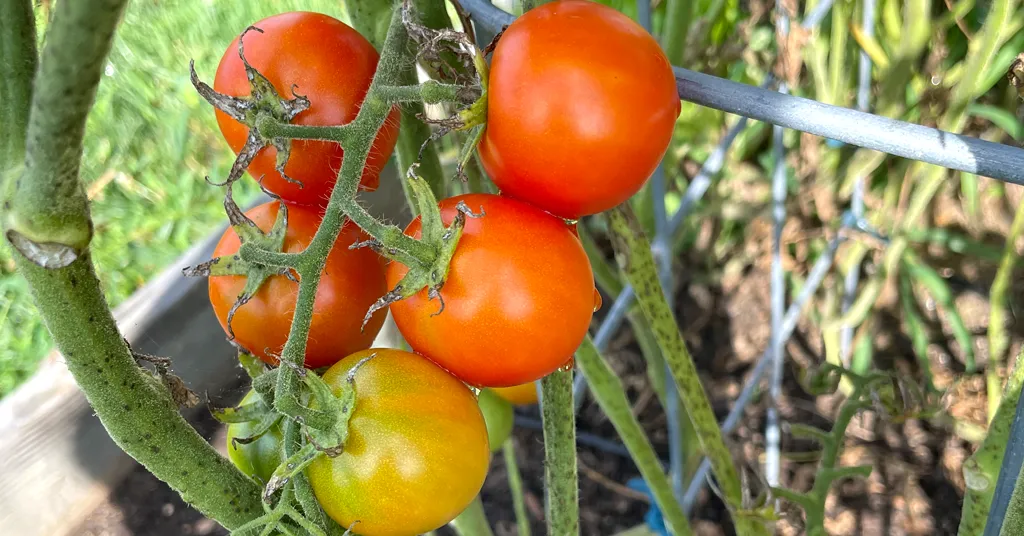
Tomato varieties come in either determinate or indeterminate types. Determinate varieties are more compact and produce fruit all at once, while indeterminate varieties continue to grow and produce fruit throughout the growing season. Determinate varieties can be planted a little closer together, while indeterminate varieties should be given more space to grow.
Plant Spacing
When planting tomatoes, it’s important to give them enough space to grow and thrive. Tomatoes need at least 18 inches of space between plants to ensure good air circulation and reduce the risk of disease. If you plan to stake or cage your tomato plants, you can plant them a little closer together. This will help them support each other as they grow. If you’re planting in containers, make sure each plant has at least a 5-gallon pot to grow in.
I typically start my tomato seeds indoors before my last frost date and then transplant them in my garden to get a quicker start on my tomato season.
The quality of your soil can affect the spacing of your tomato plants. If your soil is poor, it’s a good idea to give your plants a little extra space to encourage healthy growth. In general, it’s best to plant tomatoes in well-draining soil that’s rich in organic matter.
Companion Planting
Companion planting is the practice of planting different types of plants together to benefit each other. When companion planting, it’s important to consider the spacing requirements of each plant. Some common companion plants that work well with tomatoes are:
- Marigolds: Marigolds are a great companion plant for tomatoes as they help to deter pests such as nematodes and aphids. They also add a pop of color to your garden and are easy to grow from seed.
- Nasturtiums: Nasturtiums are another colorful companion plant that can help to repel aphids and other pests. They also attract beneficial insects such as ladybugs and lacewings, which can help to keep your tomato plants healthy.
- Basil: As mentioned earlier, basil is a great companion plant for tomatoes as it can help to improve their flavor and deter pests. Plus, basil is a tasty herb that you can use in your cooking.
- Borage: Borage is a hardy annual plant that attracts bees and other beneficial insects to your garden. It’s also thought to improve the flavor of tomatoes and other vegetables when planted nearby.
- Carrots: Carrots are a great companion plant for tomatoes as they help to loosen the soil and improve its structure. They also grow well together as they have similar water and nutrient needs.
By planting these companion plants alongside your tomatoes, you can help to create a healthier and more productive garden. Just be sure to give each plant enough space and consider their growing requirements when planning your garden layout.
Growing Tomatoes: Care and Maintenance
Tomatoes need a lot of sunlight, so make sure to plant them in a spot that receives at least six to eight hours of direct sunlight each day. They also need well-draining soil that’s rich in organic matter.
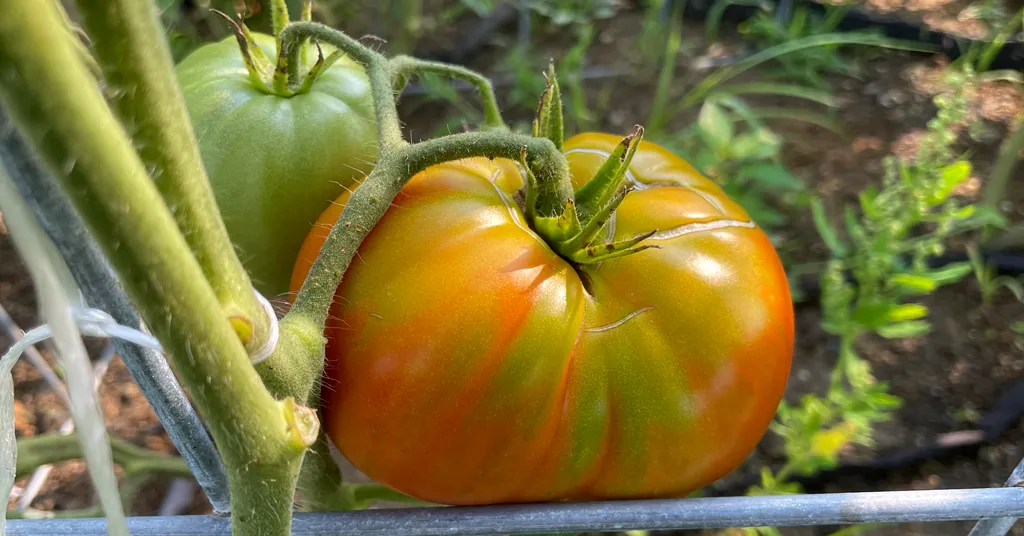
Growing tomatoes need consistent watering throughout the growing season. They prefer deep, infrequent watering rather than frequent shallow watering. It’s a good idea to water your tomato plants once or twice a week, depending on the weather and soil moisture.
Tomatoes are heavy feeders and require regular fertilization to produce healthy fruit. You can use a balanced fertilizer or one that’s high in phosphorus, which is important for fruit development. Be careful not to over-fertilize, as this can lead to excessive foliage growth and fewer fruit.
Mulching around your tomato plants can help to conserve soil moisture and suppress weeds. You can use a variety of materials for mulch, such as straw, leaves, or grass clippings.
By following these care and maintenance tips, you can help to ensure that your tomato plants are healthy and productive throughout the growing season.
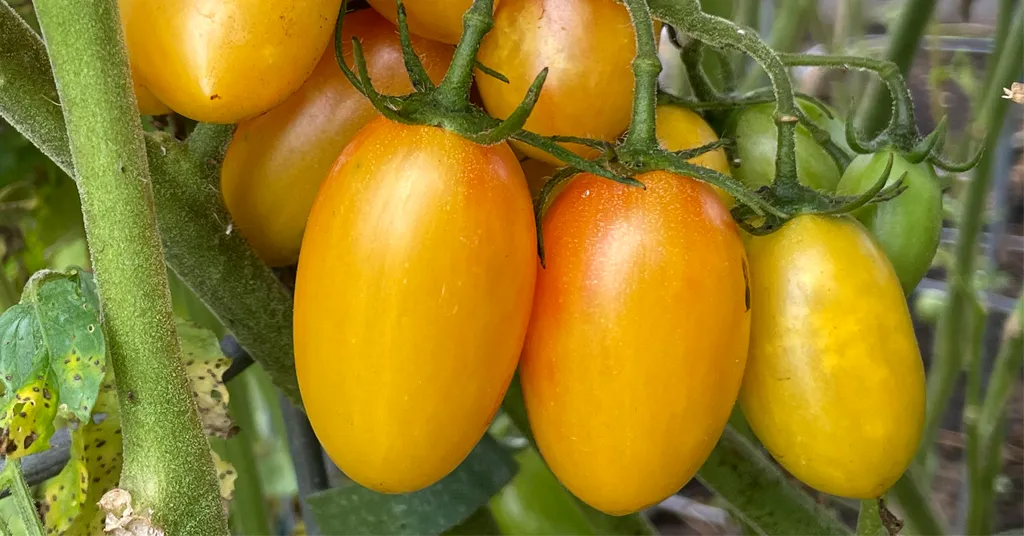
Pruning and Training
When growing tomatoes they need support to grow, so consider using stakes, cages, or trellises to keep them upright. This also makes it easier to prune and harvest from the plants.
- Staking: Staking involves using a wooden or metal stake to support the tomato plant as it grows. You can tie the plant to the stake with soft twine or tomato clips. Staking is a good option for determinate tomato varieties, which grow to a more compact size.
- Caging: Caging involves placing a wire or plastic cage around the tomato plant to keep it upright. This is a good option for indeterminate tomato varieties, which can grow quite tall and require more support. I have created my cages because I feel that the cages you can purchase at a big box store are not strong enough to support my tomatoes. I have cut cattle panels into 6-foot high cages and bent them at a 90-degree angle so they stand up on their own.
- Trellising: Trellising involves creating a support structure for the tomato plant using a series of wires or strings. This is a good option for larger gardens where you have many tomato plants to support. Some people utilize cattle panel trellis to support their tomato plants.
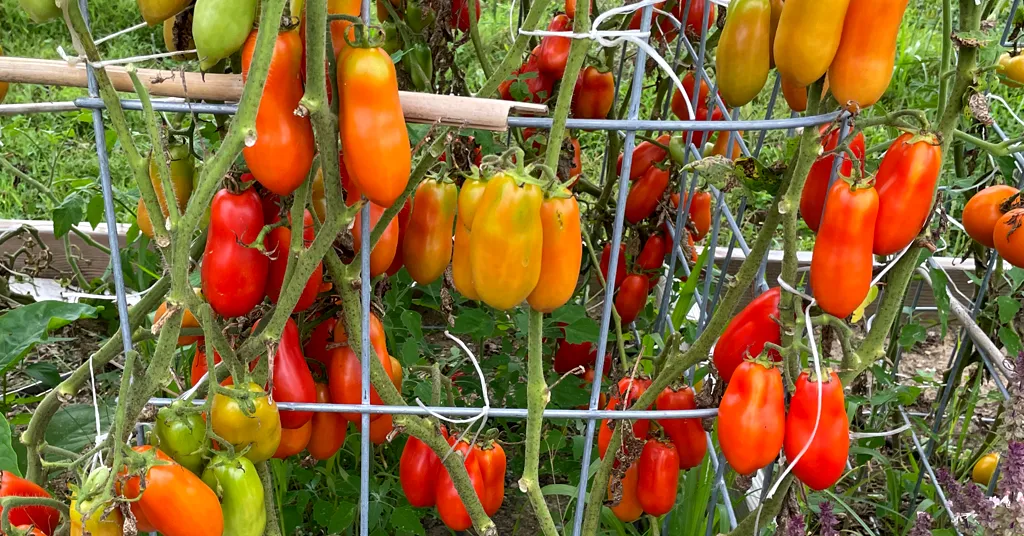
Prune the tomato plants by removing the suckers, which are the small shoots that grow between the main stem and branches. This will help the plant focus its energy on producing fruit rather than foliage. In addition to removing suckers, it’s also a good idea to prune your tomato plants to improve air circulation and reduce the risk of disease. You can prune off any damaged or diseased leaves, as well as any branches that are growing towards the center of the plant.
Pest Control
Tomatoes are susceptible to a variety of pests, including aphids, cutworms, and hornworms.
- Aphids: You can try spraying the plants with a mixture of dish soap and water. You can also attract natural predators of aphids, such as ladybugs and lacewings, to your garden by planting flowers like marigolds and daisies.
- Cutworms: Try using collars made of cardboard or plastic to protect your plants from cutworms, You can also sprinkle diatomaceous earth around the base of the plant. This natural pest control method works by dehydrating and killing the cutworms.
- Hornworms: If you notice hornworms on your tomato plants, you can pick them off by hand and dispose of them. Hornworms glow in blacklight. Go out at night with a black light and they are much easier to spot on your tomato plants and you can pick them off easier. You can also attract natural predators of hornworms, such as parasitic wasps and braconid wasps, to your garden by planting flowers like parsley and dill.
- Other pests: In addition to aphids, cutworms, and hornworms, tomato plants can also be susceptible to other pests such as spider mites, whiteflies, and tomato fruitworms. To control these pests, you can use organic pest control methods such as neem oil or insecticidal soap.
By monitoring your growing tomato plants for pests and taking proactive measures to control them, you can help prevent damage to the plants and ensure a healthy harvest.
Disease Control
Tomatoes can be susceptible to a variety of diseases that can impact plant health and reduce crop yields. Here are some common tomato diseases and tips on how to prevent them in your garden:
- Early Blight: Early blight is a fungal disease that causes dark spots on the leaves, which eventually turn yellow and fall off. The disease can also affect the fruit, causing it to rot. To prevent early blight, make sure to rotate your tomato plants every year, and avoid watering the leaves. If you notice early signs of the disease, you can treat it with copper fungicide.
- Late Blight: Late blight is another fungal disease that can cause significant damage to tomato plants. It typically appears on the leaves as a dark, oily spot that eventually spreads to the fruit, causing it to rot. To prevent late blight, avoid overhead watering, and make sure to space out your tomato plants to improve air circulation. If you notice late blight, remove and destroy any infected plants immediately.
- Verticillium Wilt: Verticillium wilt is a soil-borne fungal disease that causes the leaves to wilt and yellow. The disease can also cause stunted growth and reduced fruit production. To prevent verticillium wilt, make sure to rotate your tomato plants every year and avoid planting them in the soil where other susceptible plants, such as potatoes, have been grown. There are no effective treatments for verticillium wilt, so prevention is key.
- Fusarium Wilt: Fusarium wilt is another soil-borne fungal disease that causes the leaves to wilt and turn yellow. The disease can also cause stunted growth and reduced fruit production. To prevent fusarium wilt, follow the same preventative measures as for verticillium wilt, including crop rotation and avoiding planting in the soil where other susceptible plants have been grown. There are no effective treatments for fusarium wilt, so prevention is key.
- Blossom End Rot: Blossom end rot is a physiological disorder caused by a calcium deficiency. It appears on the bottom of the fruit as a dark, sunken spot. To prevent blossom end rot, make sure your soil has adequate levels of calcium, and avoid over-fertilizing your tomato plants. You can also add crushed eggshells or bone meal to your soil to increase calcium levels.
By following these preventative measures and monitoring your tomato plants regularly for signs of disease, you can help keep your plants healthy and productive throughout the growing season.
What to do with the Tomatoes I grew?
Now if you have read any of my other articles on the blog you know I love to can things so I can extend my harvest. We do use tomatoes for a lot of fresh eating as well. I tend to plant many more tomato plants than we can sustain fresh eating so I can ensure I have enough to can with as well. Some of my favorite ways to can tomatoes are:
I hope you enjoy growing tomatoes as much as I do. Comment on this post and let me know what your favorite way to use tomatoes is.
More posts in our Growing Vegetables Series:

